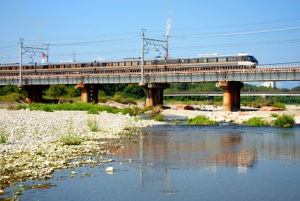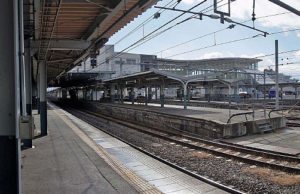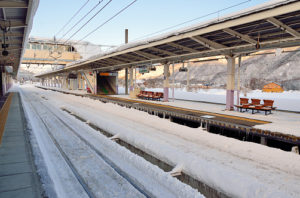
Getting from Central Nagoya to Hakuba Valley
Getting from Central Nagoya to Hakuba Valley
Nagoya is Japan's 4th largest city, with a population of over 2 million. Nagoya Station is on the Tokaido Shinkansen Bullet train line that runs from Tokyo through Kyoto and Osaka, and on to Fukuoka. It is central Japan's largest hub station. In addition to the JR Station, there are also Kintetsu Rail Co, and Meitetsu Rail Co Stations, as well as a couple of subway lines. Below we offer the simplest transfer from Nagoya to Hakuba Valley. If you have something else in mind, then please contact us using the form on this page and we give you the best advice we can. | |
While the area around and above Nagoya Station is very modern, the station and platforms are quite dated. Nagoya Station is quite large with 17 platforms in the JR Station alone. The Shinkansen Bullet trains use platforms 14-17, while the other platforms are used by commuter and express trains. Buying a Ticket JR Nagoya Station has 3 main entrances / exits. Sakuradori to the East, Taiko Dori Exit to the West, and Hirokoji Exit to the South-East. Most people will be using the Sakuradori Entrance, however if coming from Chubu Airport, then the Hirokoji Entrance is the closest. There are ticket vending machines (multi-lingual) here as well as ticket counters. Unless you take the 08:00 train and connect with the “Azusa Express” in Matsumoto, you will need to purchase a basic fare ticket from Nagoya to Hakuba, and then an Express fare from Nagoya to Matsumoto. If you do manage to get the 8am train then you can go the whole way by express (see below for details). The easiest option is to go to a ticket counter and talk to the person selling tickets. They will be able to give you the correct times. | |
Hirokoji Exit / Entrance at JR Nagoya Station | Nagoya Station Concourse |

Shinano Wide View Express
The train from Nagoya to Matsumoto (and on to Nagano) is called “Shinano Wide View Limited Express”. Limited Express are the 2nd fastest type of train in Japan after the Shinkansen Bullet train. They only stop at larger stations, and by-pass the commuter ones. The train from Nagoya to Matsumoto will only stop at about 7 stations along the way and take about 2 hours.
There are 6 carriages on the train. #1 is the front of the train heading towards Matsumoto, while 6 is the rear of the train.
Car 1 is Green Class (first class) and a surcharge is required in addition to the limited express fare.
Cars 2-4 are reserved sets. These are for people with seat assignments on their tickets.
Cars 5-6 are non-reserved, meaning these seats are on a first come basis.
There is no food or beverage service on this train so it pays to buy a few snacks at Nagoya Station before boarding.
Boarding the Train
Most of the Wide View Shinano Trains depart from platform #10, but you need to check the digital signs at the station entrance to confirm this as it can change on occasion.
The ticket sales and ticket gates are on the basement level. There are 3 pathways to the platforms (North, Central, and South). You walk along the tunnel like corridor and there are a number of staircases (and escalators on the North and Central pathways). These have the platform numbers on them. At the platform 10 sign, climb the stairs and you will be on the ground level on the platform.
There are small convenience stores on the platform where you can buy snacks and drinks.
The train will arrive 5-10 minutes before departure.
Nagoya to Matsumoto
The trip from Nagoya to Matsumoto takes about 2 hours. After leaving Nagoya the train travels through the suburbs before following a number of river valleys. Between the many tunnels, there are some great valley views on both sides of the train.
For much of the way the train follows the old Nakasendo route. This is the ancient walkway from Osaka to Tokyo through the mountains. Many of the townships you pass through on the way are the old staging towns where weary travelers would stay over night in small Japanese style lodges.

The train makes a brief stop at Matsumoto before continuing on to Nagano. So get your luggage together and and move to the end of the carriage shortly before you arrive. You will generally arrive at platform 3 at Matsumoto Station.
If you are catching the Limited Express Azusa to Hakuba then you need to head to platform 4. If not then generally will head to platform 6, but you will need to check on the digital signs.
Matsumoto Station is quite small and you generally only need 5 minutes to transfer trains here.
Matsumoto to Hakuba
If you did not make the above Shinano / Azusa Combo, then you need to take local trains on the JR Oito Line to get to Hakuba. While there are a couple of trains a day that go all the way through to Hakuba, in most cases there will be another train change in Shinano Omachi along the way.

Arrival in Hakuba
Hakuba is a very small station, with only 3 platforms, 1 exit, and not many trains. Most trains arrive at platform 1, which is right next to the exit. There is no automatic ticket gates here, so you give your tickets to the station staff.
On exiting the station there is a taxi stand right in front of you. Many accommodation properties will pick you up from Hakuba station if you give them a call.
Nagoya is Japan's 4th largest city, with a population of over 2 million. Nagoya Station is on the Tokaido Shinkansen Bullet train line that runs from Tokyo through Kyoto and Osaka, and on to Fukuoka. It is central Japan's largest hub station. In addition to the JR Station, there are also Kintetsu Rail Co, and Meitetsu Rail Co Stations, as well as a couple of subway lines. Below we offer the simplest transfer from Nagoya to Hakuba Valley. If you have something else in mind, then please contact us using the form on this page and we give you the best advice we can. | |
While the area around and above Nagoya Station is very modern, the station and platforms are quite dated. Nagoya Station is quite large with 17 platforms in the JR Station alone. The Shinkansen Bullet trains use platforms 14-17, while the other platforms are used by commuter and express trains. Buying a Ticket JR Nagoya Station has 3 main entrances / exits. Sakuradori to the East, Taiko Dori Exit to the West, and Hirokoji Exit to the South-East. Most people will be using the Sakuradori Entrance, however if coming from Chubu Airport, then the Hirokoji Entrance is the closest. There are ticket vending machines (multi-lingual) here as well as ticket counters. Unless you take the 08:00 train and connect with the “Azusa Express” in Matsumoto, you will need to purchase a basic fare ticket from Nagoya to Hakuba, and then an Express fare from Nagoya to Matsumoto. If you do manage to get the 8am train then you can go the whole way by express (see below for details). The easiest option is to go to a ticket counter and talk to the person selling tickets. They will be able to give you the correct times. | |
Hirokoji Exit / Entrance at JR Nagoya Station | Nagoya Station Concourse |

Shinano Wide View Express
The train from Nagoya to Matsumoto (and on to Nagano) is called “Shinano Wide View Limited Express”. Limited Express are the 2nd fastest type of train in Japan after the Shinkansen Bullet train. They only stop at larger stations, and by-pass the commuter ones. The train from Nagoya to Matsumoto will only stop at about 7 stations along the way and take about 2 hours.
There are 6 carriages on the train. #1 is the front of the train heading towards Matsumoto, while 6 is the rear of the train.
Car 1 is Green Class (first class) and a surcharge is required in addition to the limited express fare.
Cars 2-4 are reserved sets. These are for people with seat assignments on their tickets.
Cars 5-6 are non-reserved, meaning these seats are on a first come basis.
There is no food or beverage service on this train so it pays to buy a few snacks at Nagoya Station before boarding.
Boarding the Train
Most of the Wide View Shinano Trains depart from platform #10, but you need to check the digital signs at the station entrance to confirm this as it can change on occasion.
The ticket sales and ticket gates are on the basement level. There are 3 pathways to the platforms (North, Central, and South). You walk along the tunnel like corridor and there are a number of staircases (and escalators on the North and Central pathways). These have the platform numbers on them. At the platform 10 sign, climb the stairs and you will be on the ground level on the platform.
There are small convenience stores on the platform where you can buy snacks and drinks.
The train will arrive 5-10 minutes before departure.
Nagoya to Matsumoto
The trip from Nagoya to Matsumoto takes about 2 hours. After leaving Nagoya the train travels through the suburbs before following a number of river valleys. Between the many tunnels, there are some great valley views on both sides of the train.
For much of the way the train follows the old Nakasendo route. This is the ancient walkway from Osaka to Tokyo through the mountains. Many of the townships you pass through on the way are the old staging towns where weary travelers would stay over night in small Japanese style lodges.

The train makes a brief stop at Matsumoto before continuing on to Nagano. So get your luggage together and and move to the end of the carriage shortly before you arrive. You will generally arrive at platform 3 at Matsumoto Station.
If you are catching the Limited Express Azusa to Hakuba then you need to head to platform 4. If not then generally will head to platform 6, but you will need to check on the digital signs.
Matsumoto Station is quite small and you generally only need 5 minutes to transfer trains here.
Matsumoto to Hakuba
If you did not make the above Shinano / Azusa Combo, then you need to take local trains on the JR Oito Line to get to Hakuba. While there are a couple of trains a day that go all the way through to Hakuba, in most cases there will be another train change in Shinano Omachi along the way.

Arrival in Hakuba
Hakuba is a very small station, with only 3 platforms, 1 exit, and not many trains. Most trains arrive at platform 1, which is right next to the exit. There is no automatic ticket gates here, so you give your tickets to the station staff.
On exiting the station there is a taxi stand right in front of you. Many accommodation properties will pick you up from Hakuba station if you give them a call.


